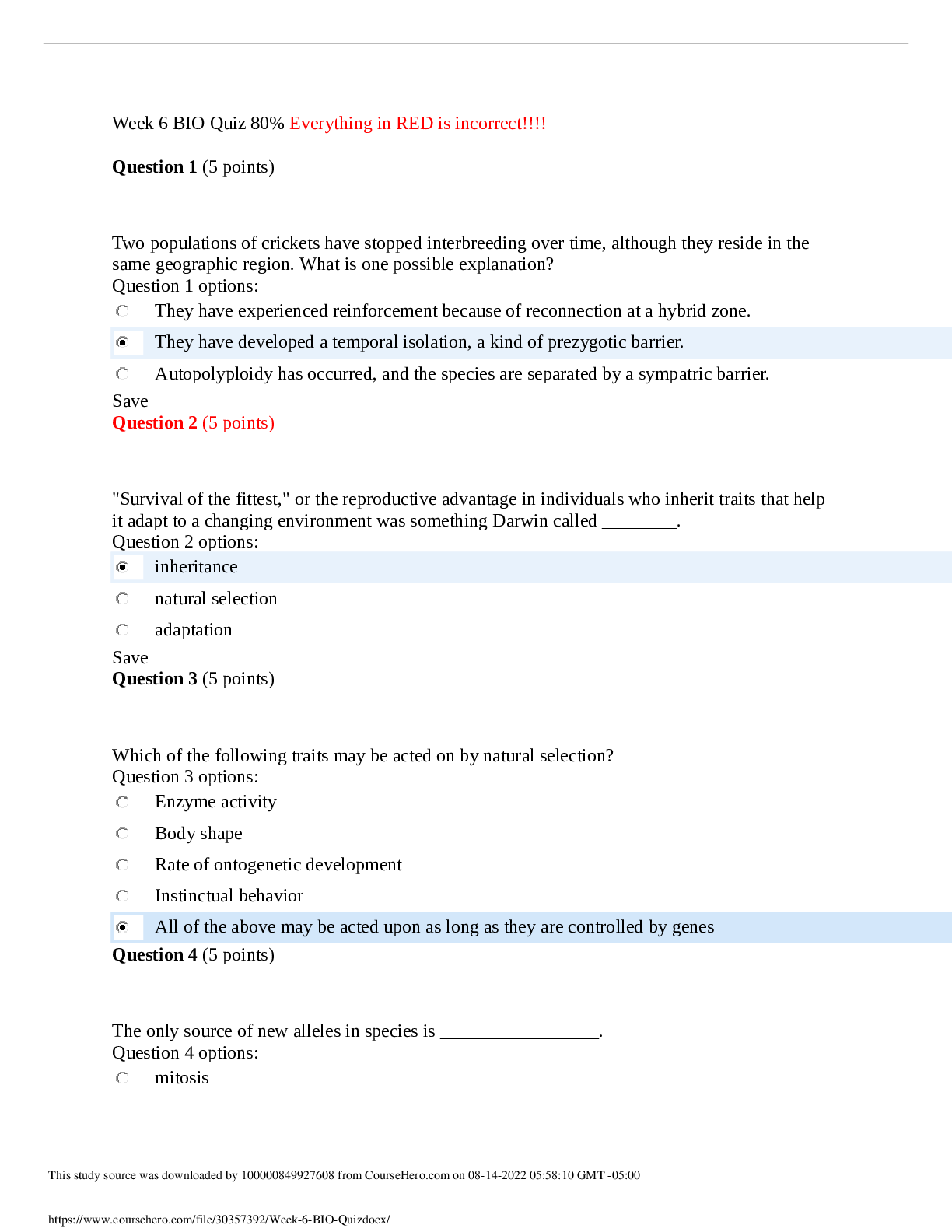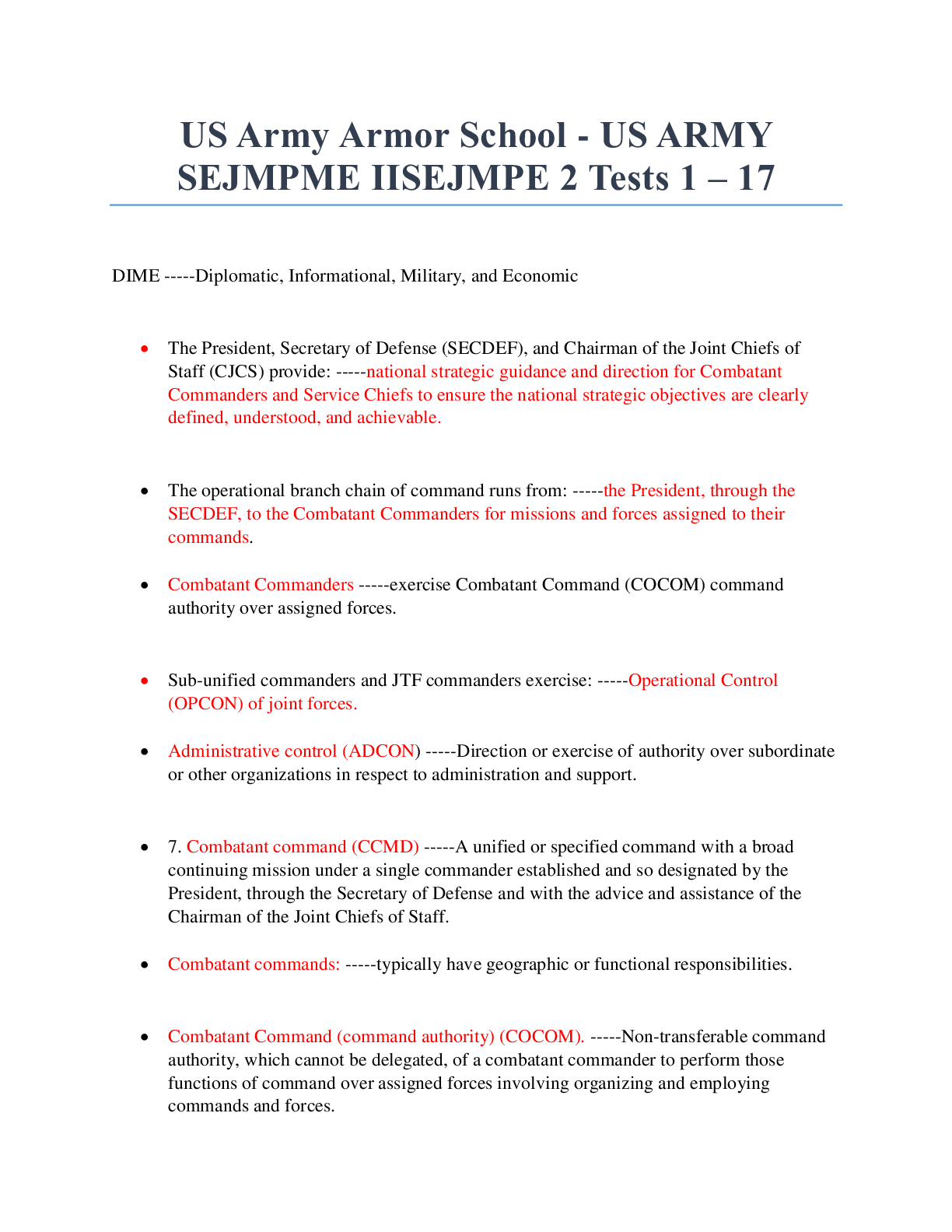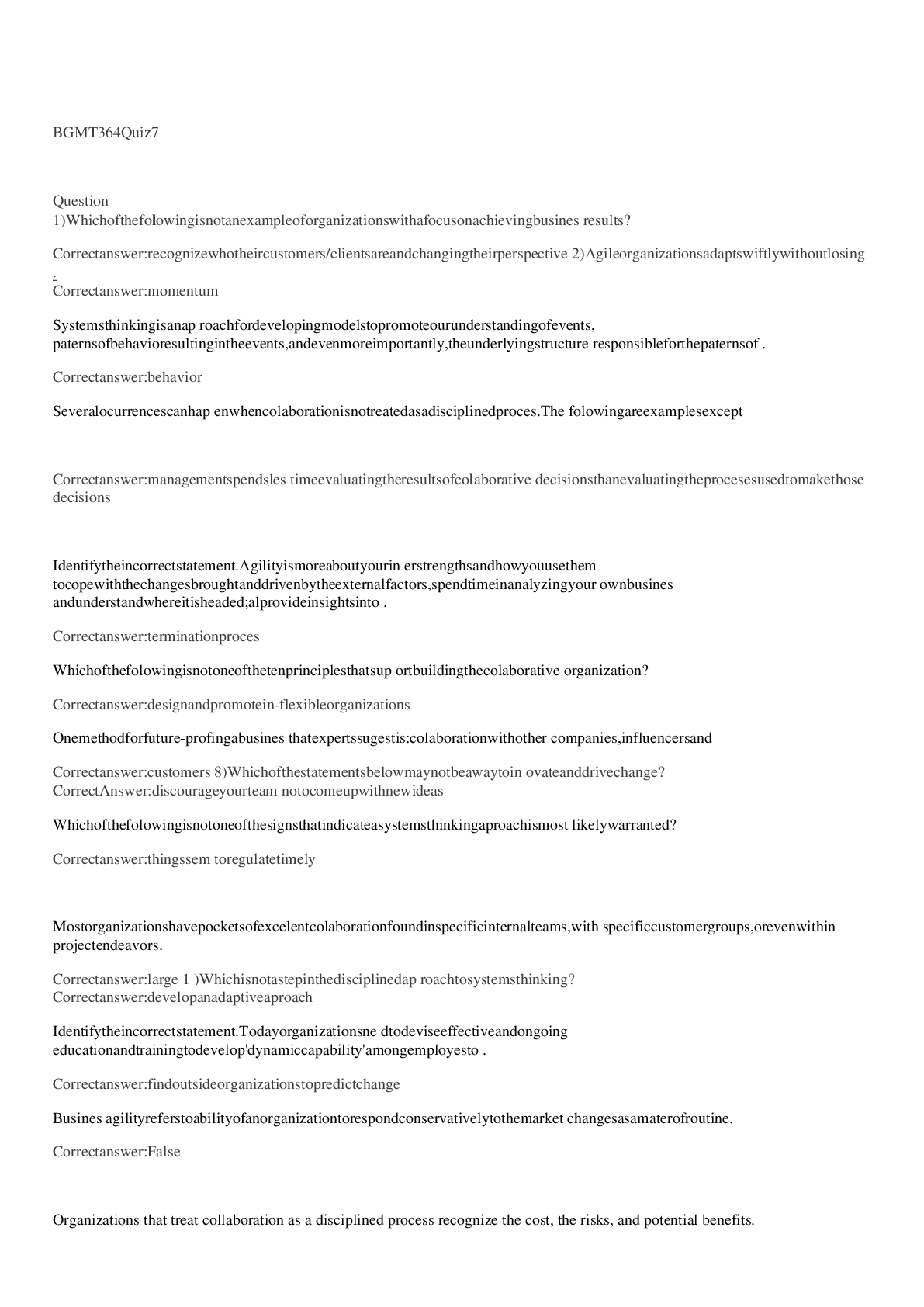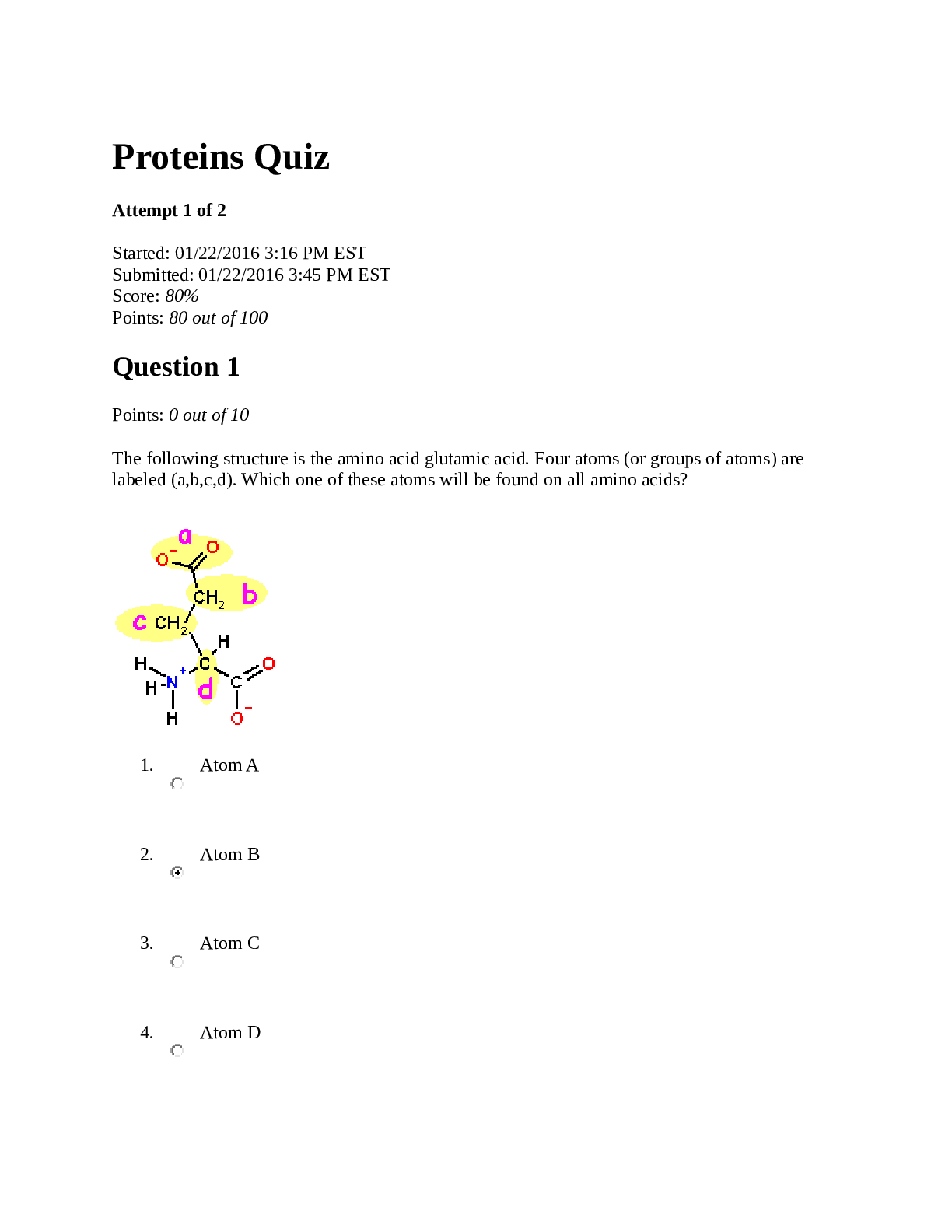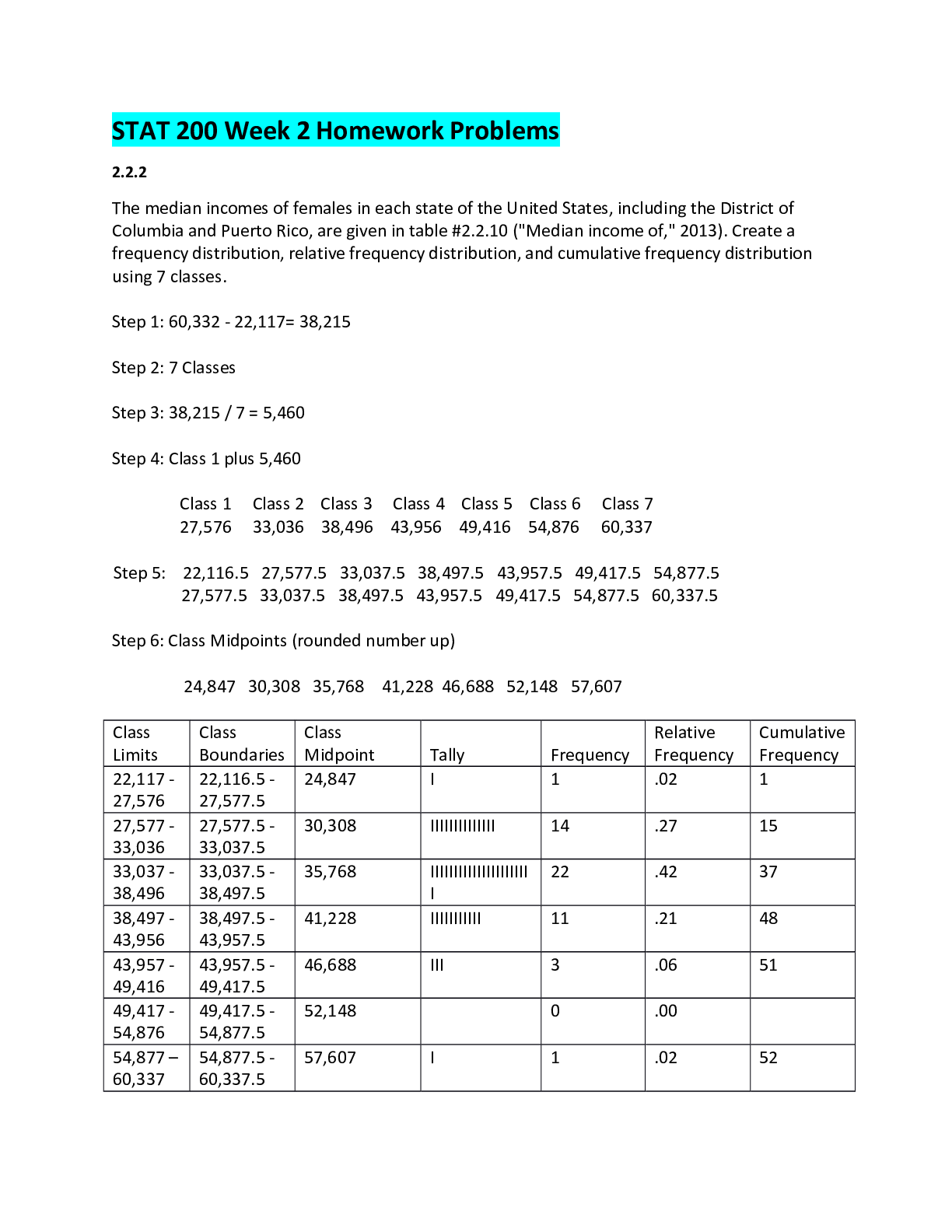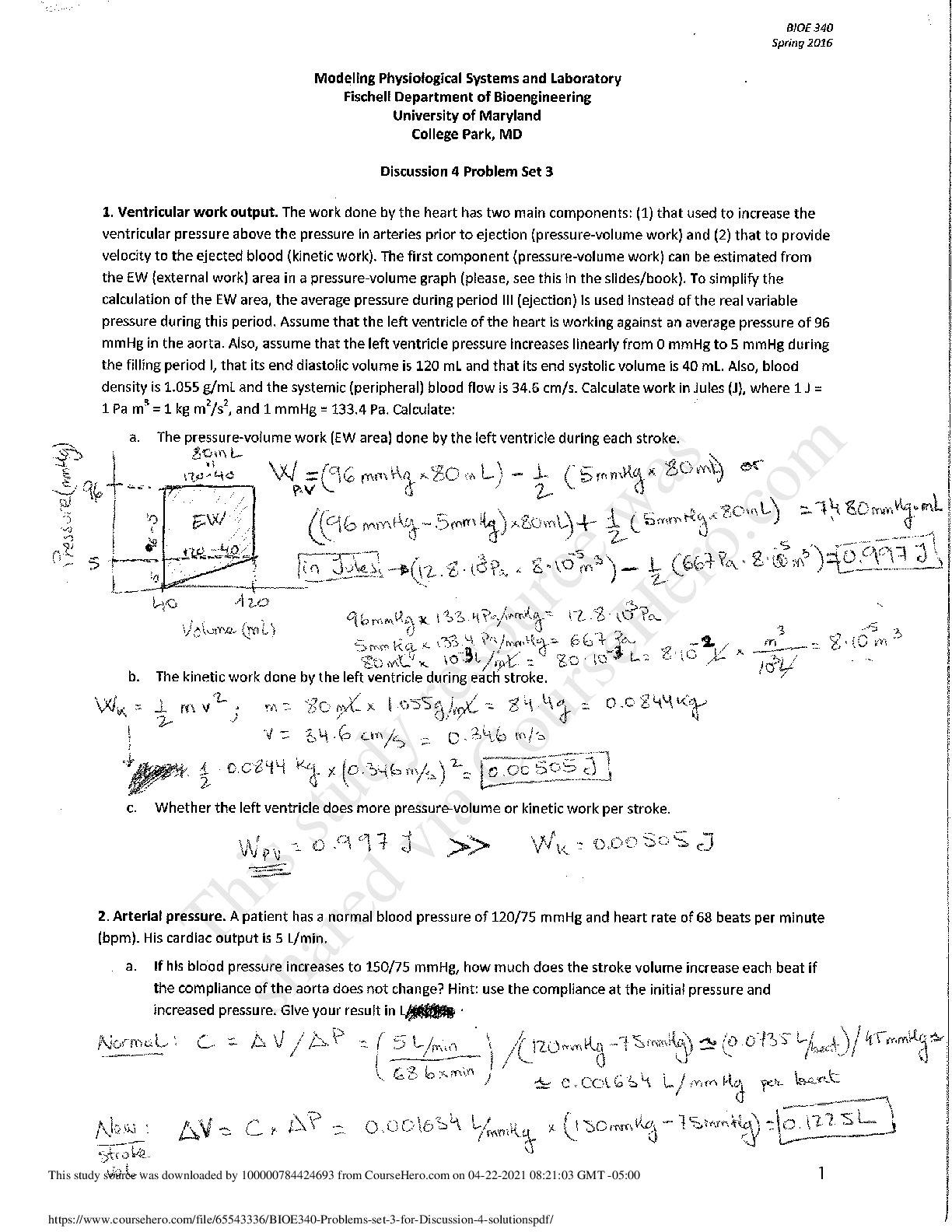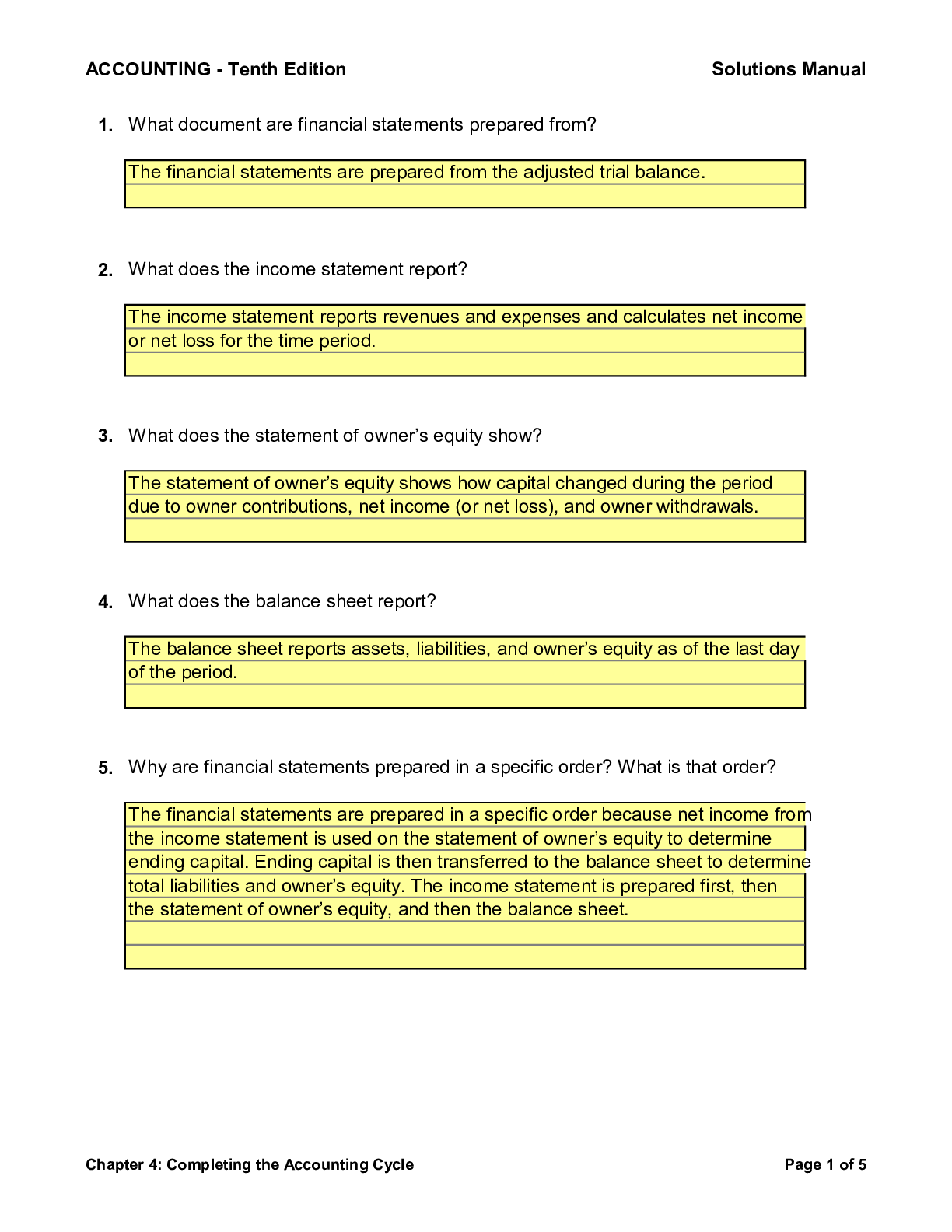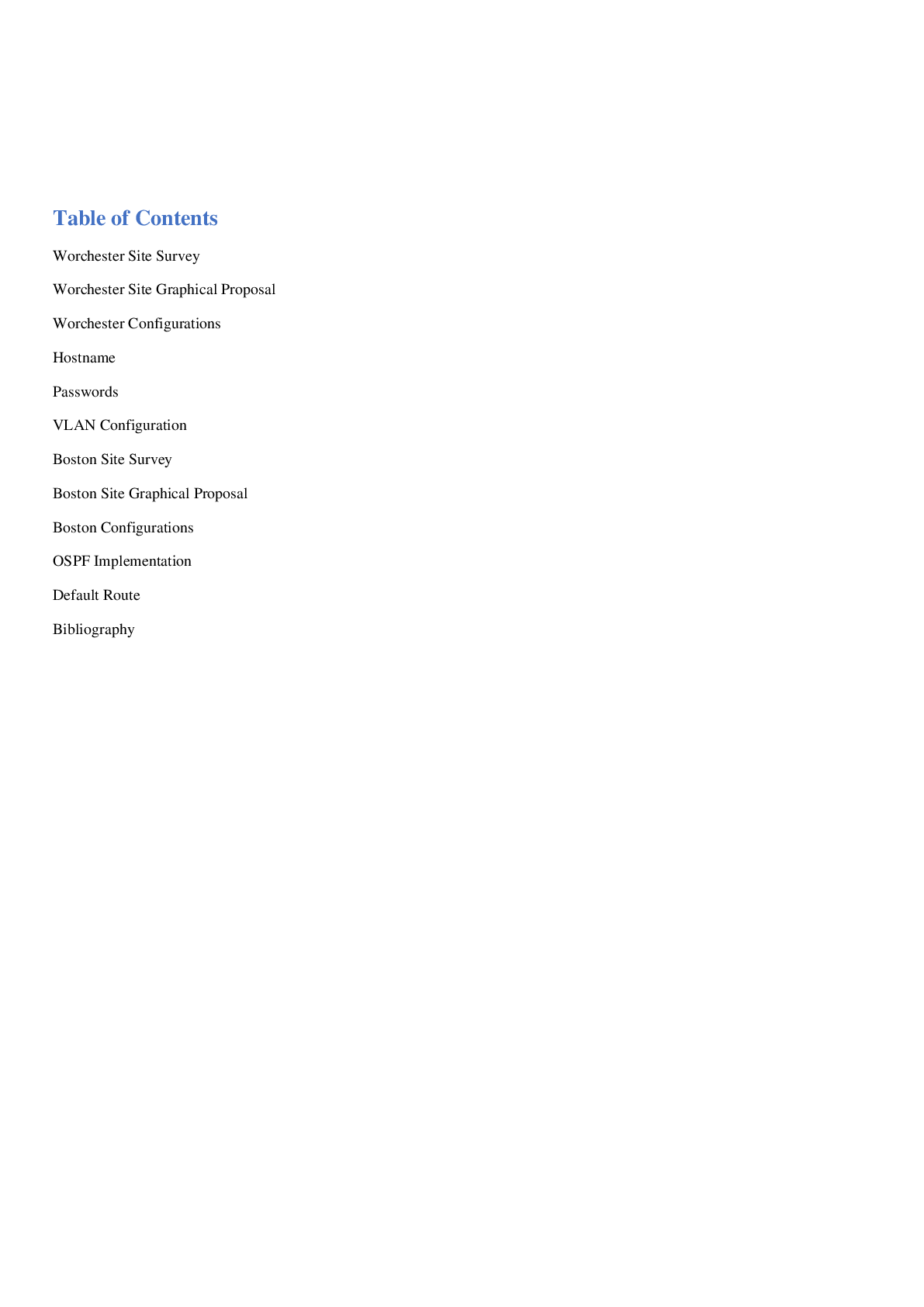Biology > QUESTIONS & ANSWERS > University of Maryland, University College BIOL 101 FINAL EXAM-ONLINEBIOL 101 Final Exam (All)
University of Maryland, University College BIOL 101 FINAL EXAM-ONLINEBIOL 101 Final Exam
Document Content and Description Below
University of Maryland, University College BIOL 101 FINAL EXAM-ONLINEBIOL 101 Final Exam University of Maryland University College Multiple Choice Questions: 1. You have formulated a hypothe... sis that water is necessary for seed germination. To test your hypothesis, one set of lettuce seeds is placed in water with warm temperatures and adequate lighting. Another set of identical seeds is placed in the dry under the same set of conditions. The control in the experiment is (a) seeds in the dry (b) seeds in the light (c) warm temperature (d) adequate humidity (e) germination rate 2. A group of medical researchers recently tested the effects of a cholesterollowering medication, Drug A on men who had high blood levels of cholesterol. The researchers did the following experiment and obtained the indicated results. One group of 150 men took a tablet containing 40 mg of Drug A for 90 days; 120 of this group decreased their blood levels of cholesterol by at least 10 %. Another group of 150 men was given a tablet with no added Drug A for 90 days; 25 of these men decreased their blood levels of cholesterol by at least 10%. Which of the following is the most reasonable and accurate conclusion based on results obtained in this experiment? (a) Drug A is good for men (b) Drug A is found in the blood of men (c) men taking tablets supplemented with Drug A will show a decrease in cholesterol levels in the blood (d) men taking tablets supplemented with Drug A will show an increase in cholesterol levels in the blood (e) blood levels of cholesterol are not affected by oral supplementation of Drug A 3. The sexually transmissible disease syphillis has become increasingly resistant to treatment with antibiotics. What is the most likely scientific explanation? (a) The syphillis bacteria learned to avoid antibiotics (b) The syphillis bacteria changed their genes when they sensed antibiotics (c) Antibiotic-sensitive syphillis bacteria died out, but antibiotic-resistant gonorrhea bacteria have flourished and persisted (d) The antibiotic increased the mutation rate in the syphillis bacteria (e) both b and d 4. Which statement best describes the relationship between plants and animals on earth? (a) Plants produce O2 and sugars from CO2 (b) Animals produce CO2 and H2O from sugars and O2 (c) Plants produce O2 and sugars and animals produce CO2 and H2O (d) Animals produce O2 and sugars and plants produce CO2 and H2O 5. Think of the cell as a factory, in which the organelles are specialized sites of production. All cells have a power plant, the mitochondrion. Plant cells have an additional “reactor” for the production of usable energy. It is called the _____. (a) golgi body (b) rough endoplasmic reticulum (c) central vacuole (d) vesicle (e) chloroplast 6. A researcher planted seeds from four types of wheat (Types A, B, C, and D) in a greenhouse to determine which type of wheat grew fastest. The plants were grown for 10 days and measured. The results are shown below. Choose the data set that demonstrates that Type C wheat grew the fastest. 1 (a) A = 20 cm, B = 11 cm, C= 5 cm, D= 2 cm. 2 (b) A = 2 cm, B = 5 cm, C= 1 cm, D= 2 cm. 3 (c) A = 22 cm, B = 11 cm, C= 25 cm, D= 4 cm. 4 (d) A = 30 cm, B = 12 cm, C= 28 cm, D= 1 cm. 5 (e) A = 21 cm, B = 12 cm, C= 20 cm, D= 15 cm. Use the following information to answer questions 7 & 8 below. A group of medical researchers recently investigated the effects of Drug X on lowering blood pressure in a group of hypertensive middle-aged women. The researchers did the following experiment and obtained the indicated results: One group of 150 women took a tablet containing Drug X for 3 weeks – 95 of these women decreased their blood pressure by at least 10% (three women from this group dropped out of the study). Another group of 150 women was given a tablet with no added Drug X for 3 weeks – 10 of these women decreased their blood pressure by at least 10% (two women from this group dropped out of the study). 7. Which of the following was the control group in this experiment? a. the group of participants that received tablets containing Drug X. b. the group of participants that received tablets that did not contain Drug X c. the number of participants in each group at the beginning of the experiment d. the number of participants in each group at the end of the experiment e. the amount of Drug X contained in the tablet 8. Which of the following is the most reasonable and accurate conclusion based on the results obtained in this experiment? a. Drug X is good for hypertensive women. b. Drug X is good for both men and women. c. Hypertensive women receiving Drug X for 3 weeks may show a decrease in blood pressure. d. Hypertensive women receiving Drug X for 3 weeks may show an increase in blood pressure. e. Drug X has no effect on blood pressure. Fill in the Blanks: 9. You find a cell of a type you have never seen before. The cell has both no nucleus and no mitochondria. Therefore, you conclude, it must be a _______________ cell. (a) prokaryotic (b) liver (c) animal (d) bacterial (e) plant 10. A scientific theory _____________________. (a) is an experiment performed by scientists to understand their observations of nature (b) is an observable fact in nature (c) is an explanation of many observations of nature (d) is an educated guess (e) is an absolute truth that cannot be challenged or changed upon examination of new evidence 1. A substance with a pH less than 7 is ___________, while a substance with a pH greater than 7 is ___________. A ) basic, acidic B ) acidic, basic C ) basic, neutral D ) neutral, acidic E ) neutral, basic 12. A dog gets many nutrients from its food including amino acids. Which of these can be built directly using the amino acids _________________________. A ) proteins B ) carbohydrates C ) lipids D ) nucleic acids E ) glucose 13. What is the correct sequence of steps in the scientific method? I. II. III. IV. Make observations and ask a question Analyze the data Develop a hypothesis Share the results with other scientists V. Design and perform an experiment to test the hypothesis A) I>II > III > IV > V B) III > I > V > II > IV C) V> IV > III > II > I D) I> III > V >II > IV E) V > II > I > III > IV 14. You have formulated a hypothesis: “Apples contain more vitamin C than oranges.” To test your hypothesis you measure vitamin C levels in 20 oranges and 20 apples from trees that were grown in the same orchard under the same environmental conditions (temperature, rain, sunlight). This experiment was conducted twice. The control in the experiment is A) type of soil, temperature, amount of rain and sunlight in the orchard B) vitamin C levels C) oranges D) apples E) a large sample size and repeated experiment Use below paragraph for next two questions: A group of medical researchers investigated the effects of Drug X on lowering cholesterol levels in a group of men between the ages of 50 and 70 years old. The researchers did the following experiment and obtained the indicated results: One group of 150 men took a tablet containing Drug X for 3 weeks – 95 of these men decreased their cholesterol levels by at least 10% (three men from this group dropped out of the study). Another group of 150 men was given a tablet with no added Drug X for 3 weeks – 10 of these men decreased their cholesterol levels by at least 10% (two men from this group dropped out of the study). 15. Which of the following is the best hypothesis for this experiment? A) Will drug X lower cholesterol levels in men between the age of 50 and 70 years? B) Drug X will lower cholesterol levels in men. C) Since high cholesterol levels significantly increases several health risks for men, drug X is most likely beneficial. D) Men between the age of 50 and 70 years will have reduced cholesterol levels if they take drug X over a 3 week period. E) There is no significant difference in cholesterol levels between men that take drug X and those that don’t take it. 16. Which of the following was the control group in this experiment? A) the amount of Drug X contained in the tablet B) the number of participants in each group at the end of the experiment C) the group of participants that received tablets containing Drug X D) the group of participants that received tablets that did not contain Drug X E) the number of participants in each group at the beginning of the experiment 17. Where does the oxygen gas produced during photosynthesis come from? A) water B) ATP C) carbon dioxide (CO2) D) glucose E) the atmosphere 18. Which of the following are polysaccharides? A) RNA and DNA B) Glucose and sucrose C) Cholesterol and vegetable oil D) Glycogen and starch E) Adenine and thymine 19. A chemotherapy drug affects the enzyme DNA polymerase. In which part of the cell cycle does it inhibit cell division? A) Metaphase B) S phase C) G1 D) Cytokinesis E) Prophase 20. The majority of climate scientists believe that the current change in climate is caused predominantly by ________. A) an enhancement of the greenhouse effect B) a decreased reliance on fossil fuels for energy C) a thinning of the ozone layer D) a melting of the polar ice caps E) an increase in solar radiation 21. The liver cells of an animal have 24 chromosomes. How many chromosomes would you expect in this same animal? A) 6 B) 12 C) 24 D) 36 E) 48 22. You are taking a cruise from California to Hawaii. About halfway there the ship begins to sink. You are able to board a lifeboat, but now you are floating in the ocean waiting to be rescued. After several days you are so thirsty that you bend over the side of the boat and drink lots of salty seawater. What happens to your body? A) You throw up because sea salt is toxic to humans. B) You get thirstier because of osmosis. C) Salt diffuses into your cells, water follows, your cells start to expand and you feel bloated. D) Since sea water consist of 96.5% fresh water (and only 3.5% salt) you will feel much better. E) You get dehydrated because water is unable to cross the semi-permeable membranes of your cells. 23. You are spraying your garden with a pesticide and you accidentally swallow a small amount. You read on the package that this pesticide inhibits ATP synthase. Should you be worried? A) ATP synthase is part of the light dependent reaction in photosynthesis; this pesticide will therefore not affect humans. So don’t worry! B) ATP synthase is an enzyme involved in the citric acid cycle so all animals, humans included, will be affected. Call the doctor. C) ATP synthase found in the pesticide is a very toxic compound. Call the doctor. D) ATP synthase is involved in both photosynthesis and cellular respiration. Call the doctor. E) ATP synthase inhibitors will not affect humans, but there might be other toxic ingredients in the pesticide, so it is best to call the doctor to be on the safe side. 24. In the following chemical reaction, what is carbon dioxide (CO2)? 12 H20 + 6 CO2 -> 1 glucose molecule + 6 O2 A) substrate B) product C) enzyme D) activation factor E) independent variable 25. Which of the following is NOT a feature of DNA? A) Adenine (A) forms a base pair with thymine (T) B) Complimentary strands are anti-parallel, running in opposite directions C) Complimentary strands are held together by hydrogen bonds between phosphate groups D) Nucleotides within a single strand are connected by covalent bonds E) All of the above are features of DNA 26. A man who carries a harmful sex-linked gene on his X chromosome, will pass the gene on to A) All of his daughters B) Half of his daughters C) All of his sons D) Half of his sons E) All of his children 27. A double-stranded DNA molecule that has 22% guanine will have A) 28% thymine B) 22% cytosine C) 44% adenine D) 26% uracil E) Both A and B are correct 28. Which of the following variations could be subject to natural selection? A) A dog with short legs due to malnutrition is able to crawl into holes better than his litter mates B) A tree is not infested by a ground-dwelling beetle when the homeowner cuts the lower branches C) A hyena is born with a spotted fur pattern that allows it to hide in the grass better than his litter mates D) A pigeon learns that when its keeper comes near it will be fed E) All of these variations may be acted on by natural selection 29. The ability of fireflies and angler fish to produce light is an example of convergent evolution. What can you conclude about these two animals based on this information? A) They share a recent common ancestor B) They are both adapted to environments low in light C) The ability to produce light is an ancient trait D) They are found in the same location E) All of the above 30. You observe the following outside your window: A grasshopper is munching away on a leaf when a hawk swoops down and eats the grasshopper. What is the grasshopper in this situation? a) secondary consumer b) prey c) herbivore d) parasite e) both B and C 31. Which of the following statements is *NOT* true? a) The cells resulting from meiosis are diploid and the cells resulting from mitosis are haploid. b) Meiosis and mitosis both start with one cell, but meiosis ends with four and mitosis with two. c) Mitosis produces new cells for growth and repair, meiosis produces gametes. d) Mitosis goes through cytokinesis once, meiosis goes through cytokinesis twice. e) Cross over happens in meiosis, but not in mitosis. 32. All of the following are sign that a website contains reliable scientific information EXCEPT A. The site avoids anecdotal evidence B. The site backs up its claim with references to primary resources C. The site is set up to allow you to buy the product being described D. The site is frequently updated to incorporate more recent information E. The site is maintained by a reputable medical establishment 33. Which statement best describes the relationship between plants and animals on earth? A. Plants produce O2 and sugars from CO2 B. Animals produce CO2 and H2O from sugars and O2 C. Plants produce O2 and sugars and animals produce CO2 and H2O D. Animals produce O2 and sugars and plants produce CO2 and H2O E. Animals produce only O2 and plants produce only CO2. 34. The flow of genetic information is from: (a) RNA to DNA to proteins (b) (c) (d) (e) 35. Proteins to DNA to RNA DNA to RNA to Protein Protein to RNA to DNA These three compounds are unrelated The process of converting DNA into an mRNA intermediate is called: (a) (b) (c) (d) (e) 36. (a) (b) (c) (d) (e) translation transcription conjugation transformation transduction The conversion of the RNA code into a polypeptide protein chain is called: translation transcription conjugation transformation transduction 37. The use of biological sciences to manipulate organisms or specific genes inside organisms is called: (a) (b) (c) (d) (e) 38. radiology ornithology biotechnology radiology symbology In this type of horizontal DNA transfer between two bacteria, the genetic material is delivered by the help of a bacteriophage (virus). (a) (b) (c) (d) (e) translation transduction conjugation transformation transcription 39. One theory which explains why cloned animals cannot live as long or as healthy as the original is: (a) (b) (c) (d) they are not created from an egg and a sperm the DNA is tangled up and never straightens out into full chromosomes the proteins are all folded incorrectly the telomeres (ends of the chromosomes) are shortened and this is thought to lead to premature aging and senescence. (e) 40. (a) (b) (c) (d) (e) None of the above Which of the following is an example of “classical” biotechnology science? cloning cow embryos cloning a gene for an antibiotic cloning the insulin gene into E. coli selective breeding of fruit trees for fire blight resistance none of the above 41. Which of the following is not a phase of the cell cycle? (a) S (b) G1 (c) G2 (d) Q (e) 42. (a) (b) (c) (d) (e) M All of the following are phases of mitosis except for: anaphase metaphase prophase kinetophase telophase 43. When dogs become overheated, they pant. During panting, blood flow to the tounge increases and this circulates heat from the center of their body to where it can be dissipated. This is an example of A. metabolism B. homeostasis C. adaptation D. inheritance E. none of the above 44. one of these beetles rolling a ball of cow dung across a pasture. You are eager to explain, using the scientific method, why these beetles are rolling ball of cow manure. Your first step is to come up with a(n) A. experiment B. prediction C. hypothesis D. observation E. none of the above 45. Three of the following are hypotheses concerning the dung beetle's behavior, select the exception. A. The dung beetles store the balls of dung to feed on later. B. The dung beetles lay eggs in the balls of dung and young will eat the dung when they hatch. C. Only female dung beetles roll balls of dung. D. Only female dung beetles roll balls of dung E. The dung beetles use the balls of dung to construct nests. 46. You hypothesize that dung beetles lay eggs in the balls of dung and the young hatch and feed on the dung. Three of the following are reasonable predictions concerning your hypothesis, select the exception A. If dung beetles are laying eggs in the dung, the they will only roll balls of dung during daylight B. If dung beetles are laying eggs in the dung, then balls of dung placed in a container will hatch baby dung beetles C. If dung beetles are laying eggs in the dung, then most of the beetles rolling dung will be females. D. If dung beetles are laying eggs in the dung then dung rolling will be most common during the breeding season. E. None of the above 47. What is necessary for natural selection to lead to evolution A. Individuals have different traits B. Traits affect reproduction C. Traits are inherited D. All of these E. None of the above 48. In a population of long-tailed weasels in central Missouri, individuals that turn white in the winter are rare. Individual weasels that turn white in winter are much more common in the northern part of the weasel's range. This appears to be an example of A. homeostsis B. responding to stimuli C. interdependency D. natural selection E. None of the above 49. Which one of the following characteristics is not necessary in order for an object to be considered living? A. Ability to reproduce B. ability to grow C. ability to move D. ability to respond to stimuli E. none of the above 50. Which BEST describes why an allele is recessive? A. Recessive alleles are weak alleles B. Recessive alleles make no funtional gene product C. Recessive alleles are mutated forms of dominant alleles D. Recessive alleles are rare. E. None of the above ****************************************************************************** MATCHING QUESTIONS SET #1 – Match each term with the most suitable description. **Do not enter your answers here.** Type in the letter you select from the right column as the best answer on the Answer Sheet provided by your instructor. This section is worth 10 points. Term or Concept 1. Water molecule H 2. Carbon E 3. Homeostasis I 4. Ionic Bonding B 5. Covalent Bonding C 6. Carbohydrate A 7. Enzyme F 8. Acid J 9. Base G 10. Lipid D Definition/Association A. energy source B. two atoms sharing electrons C. electron donated/received D. hydrophobic E. element found in all living organisms F. catalyst G. OH-> H+ H. polar I. characteristic of all living organisms J. H+ > OH- ****************************************************************************** MATCHING QUESTIONS SET #2 MATCHING SECTION INSTRUCTIONS: Read all instructions carefully. Please answer all questions. Each question is worth # points. The Matching section is worth 10 points. Term or Concept 1. Ribosome D 2. Mitochondria G 3. Nucleus C 4. Golgi apparatus A 5. Smooth Endoplasmatic Reticulum F 6. Membrane J 7. Cell Wall E 8. Lysosome B 9. Chloroplast I 10. Cilia H Definition or Association A. packaging and transport B. digestion C. genetic material storage D. protein assembly E. structural support F. lipid production G. glucose breakdown H. movement I. oxygen production J. contain transport proteins and receptors SHORT ESSAY QUESTIONS ESSAY SECTION Complete 6 out of 10 questions in this Essay Section **Do not enter your answers here.** Type your answers into the Answer Sheet provided by your instructor. 1. You scoop up a water sample from a local pond nearby, because you are curious about the possible microbes that might live there. After looking at several slides that held drops of the sample, you noticed two different kinds of cells: One kind was very small and had no separate internal structures; the other kind was much larger, and it contained several kinds of internal structures that were physically different from each other. Please name each cell and briefly describe their overall similarities and differences. 2. PKU (phenylketonuria) is an enzyme deficiency disease that only develops in individuals who are homozygous recessive for that gene. An individual with PKU has parents that do not have this disease. What is the parents’ genotype for the gene responsible for PKU? What is the probability that they may have another child with PKU? How many future children of the affected individual will be carriers? Explain your answers. 3. Humans share 99% of their genes with chimpanzees, 90% with mice, 50% with fruit flies, and 37% with celery. Please explain the evolutionary significance of these data. 4. Describe the major land biome where you live. How have human activities changed the landscape and how has this affected native species? Include specific examples. 5. The habitat of one species of tropical fish is red coral reefs. The large majority of the fish in this population are red. A few individual fish carry a mutation that prevents the production of the red pigment; as a result these individual fish are white. The temperature of the ocean where these fish live gets warmer and warmer over a 10 year period, and as a result the coral is bleached and turns white. Use what you have learned about natural selection to explain how this bleaching event may have affected the evolution this fish population (not including possible direct effects of warmer temperatures on the fish). Include the following terms in your explanation: differential reproduction, beneficial trait, allele frequency, selection pressure, evolution. 6. Use what you have learned about energy transfer in food chains and the second law of thermodynamics to explain why it is an environmentally good choice to eat a plant based diet. Include the following terms in your answer: producer, herbivore, omnivore, trophic level, resources and energy 7. An organism that lives in salt water is almost always hypotonic to its salt water environment. Why is this a serious problem for such organisms? How do these organisms cope with the problem? 8. Lithops, also called Stoneplants, are a type of plant that resembles little stones. These plants have the ability to blend in with there surrounding, which affords them protection from predators. If you were in an area containing Lithops, describe four characteristics you could identify to distinguish these plants from the stones they mimic. 9. A population of grasshoppers in the Kansas prairie has two color phenotypes, green and brown. Typically, the prairie receives adequate water to maintain healthy, green grass. Assume a bird that eats grasshoppers moves into the prairie. How will this affect natural selection of the grasshoppers? How might this change in a drought year? 10. DNA and RNA are similar yet distinct components of the cell. Describe three differences between RNA and DNA with respect to their chemical composition and structure. Provide a detailed description of each characteristic you chose in your response. [Show More]
Last updated: 1 year ago
Preview 1 out of 16 pages

Reviews( 0 )
Document information
Connected school, study & course
About the document
Uploaded On
Aug 14, 2022
Number of pages
16
Written in
Additional information
This document has been written for:
Uploaded
Aug 14, 2022
Downloads
0
Views
30





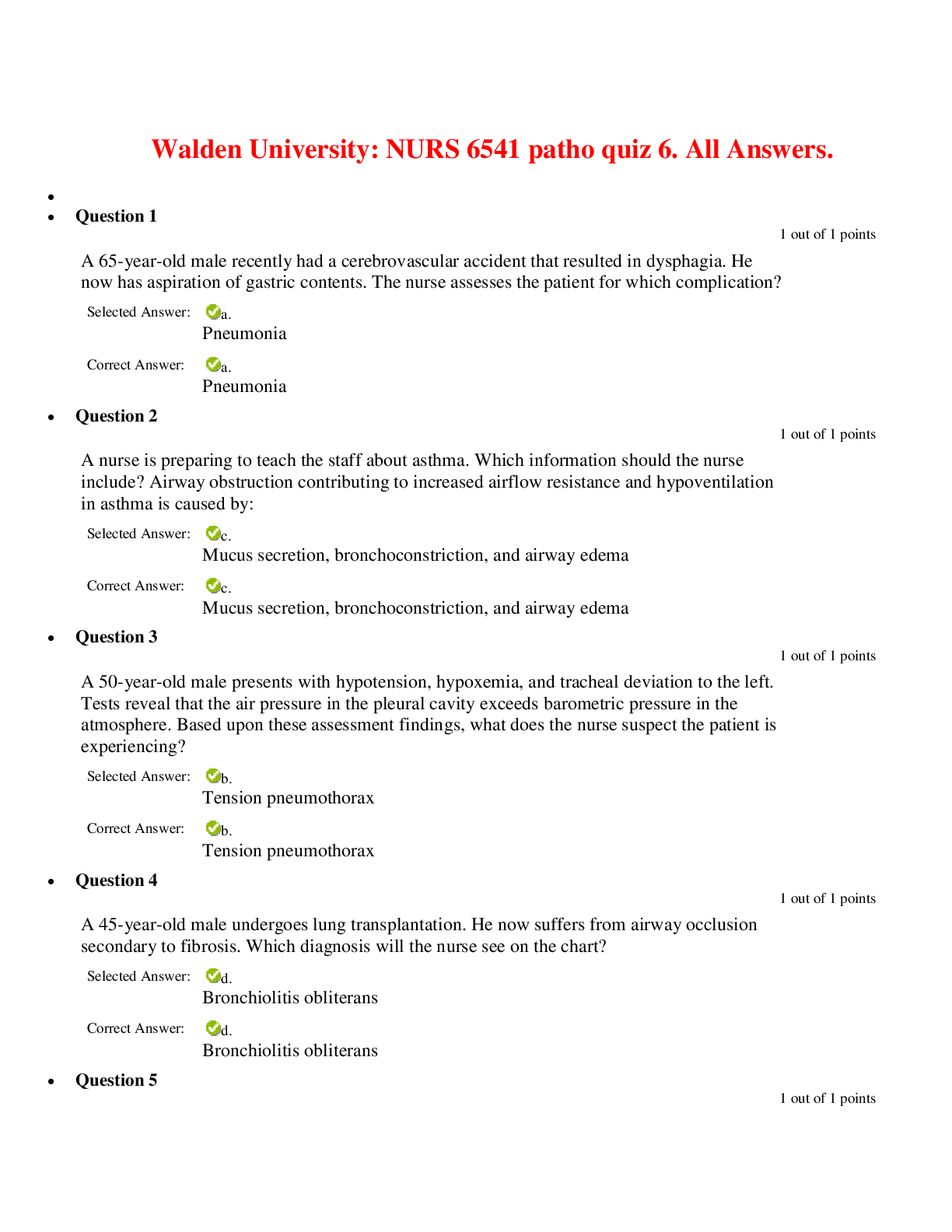





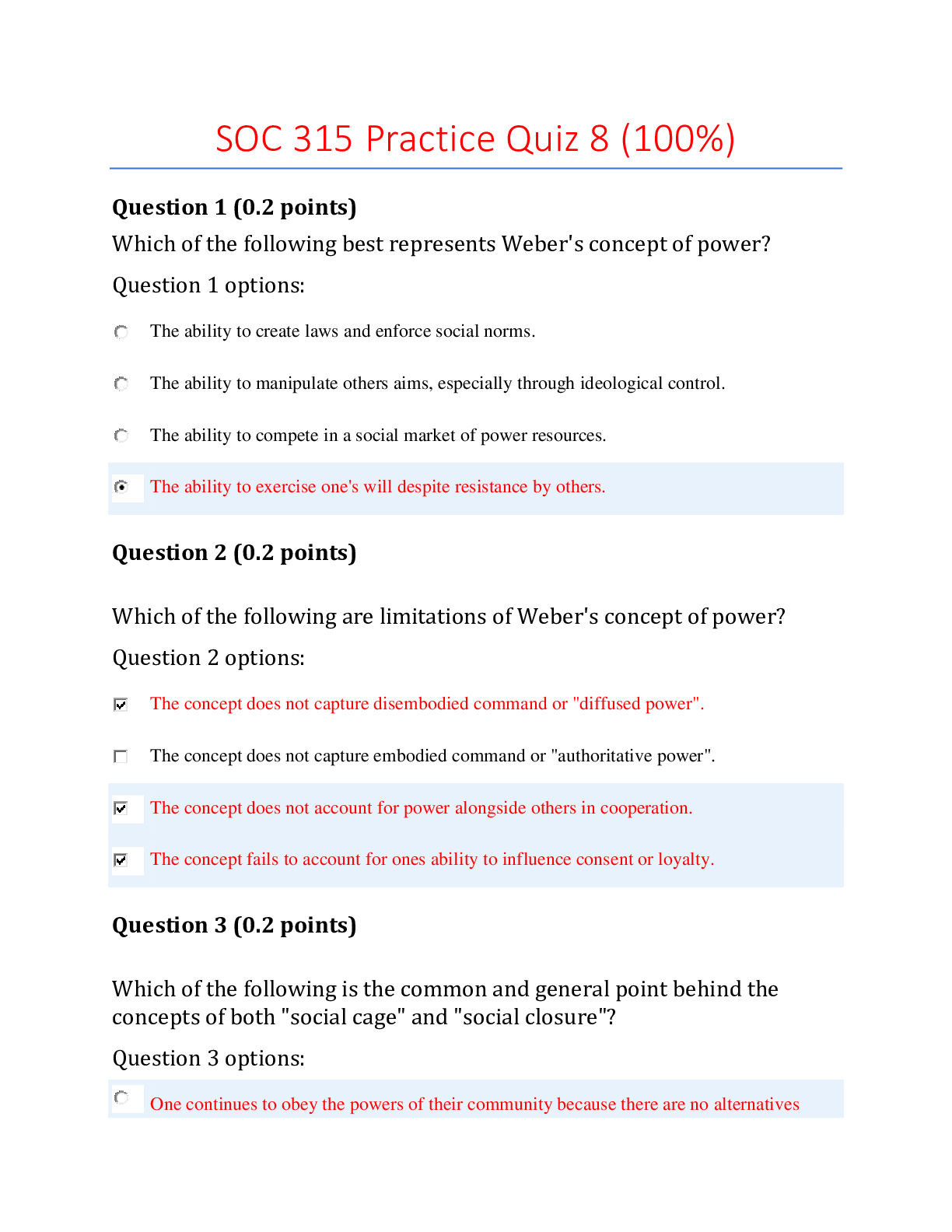
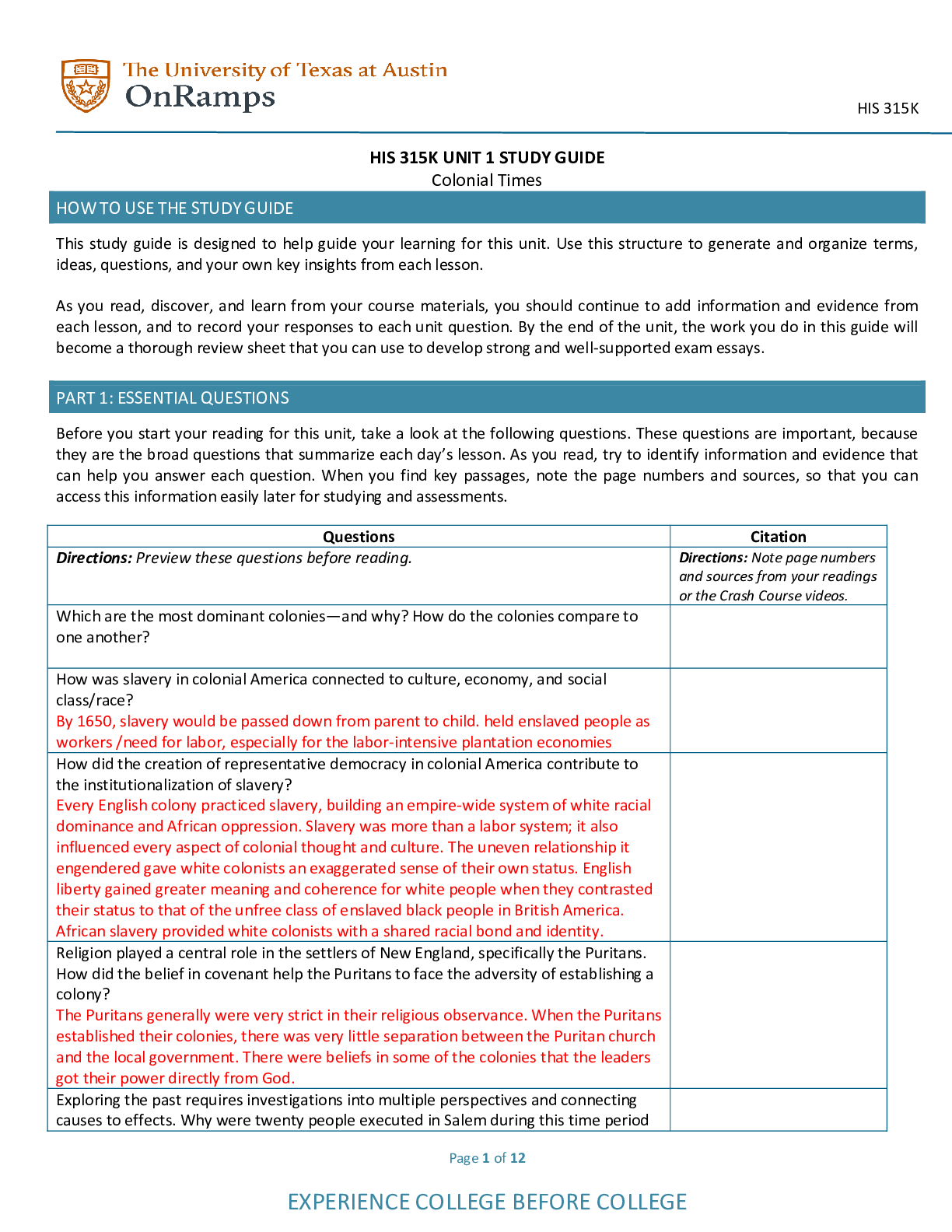
.png)

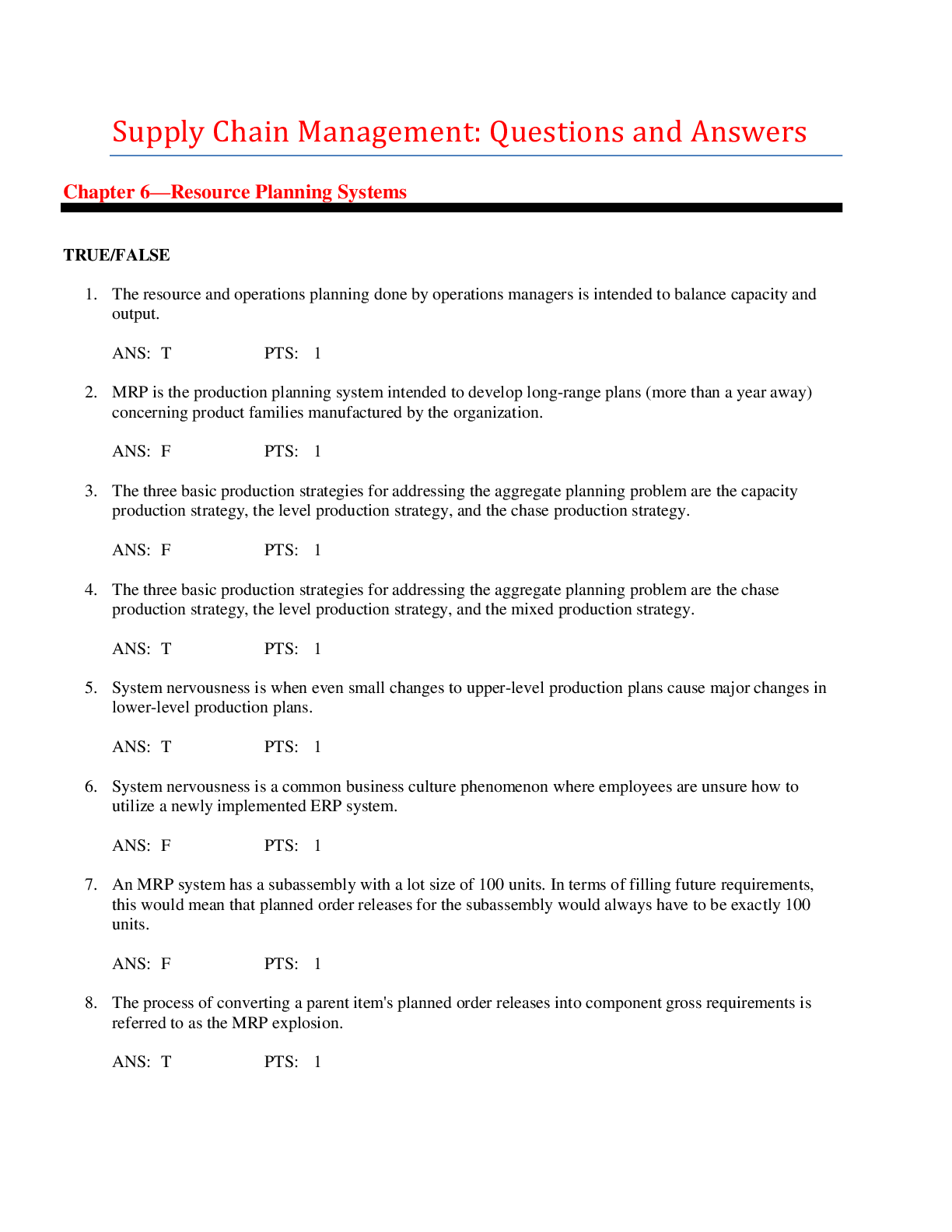
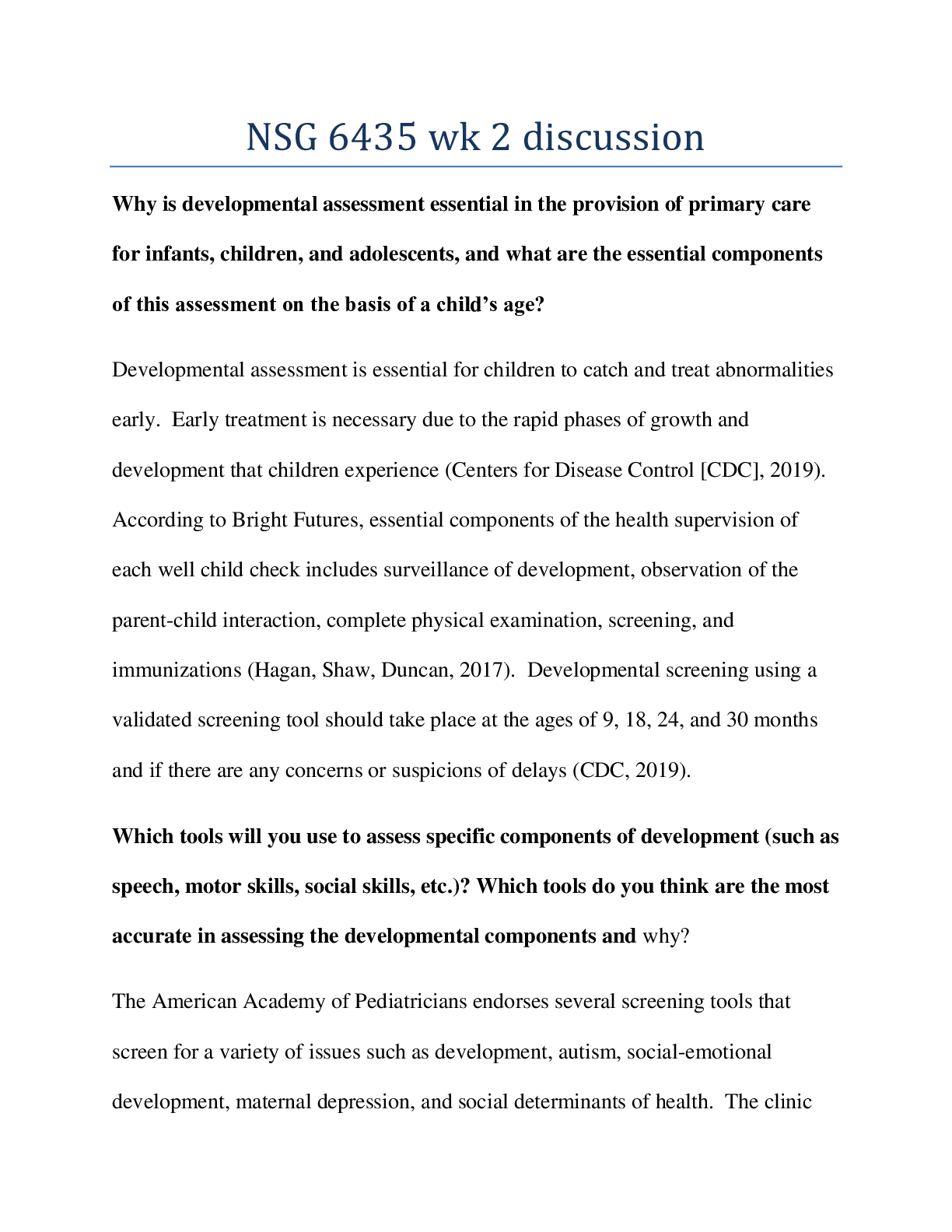
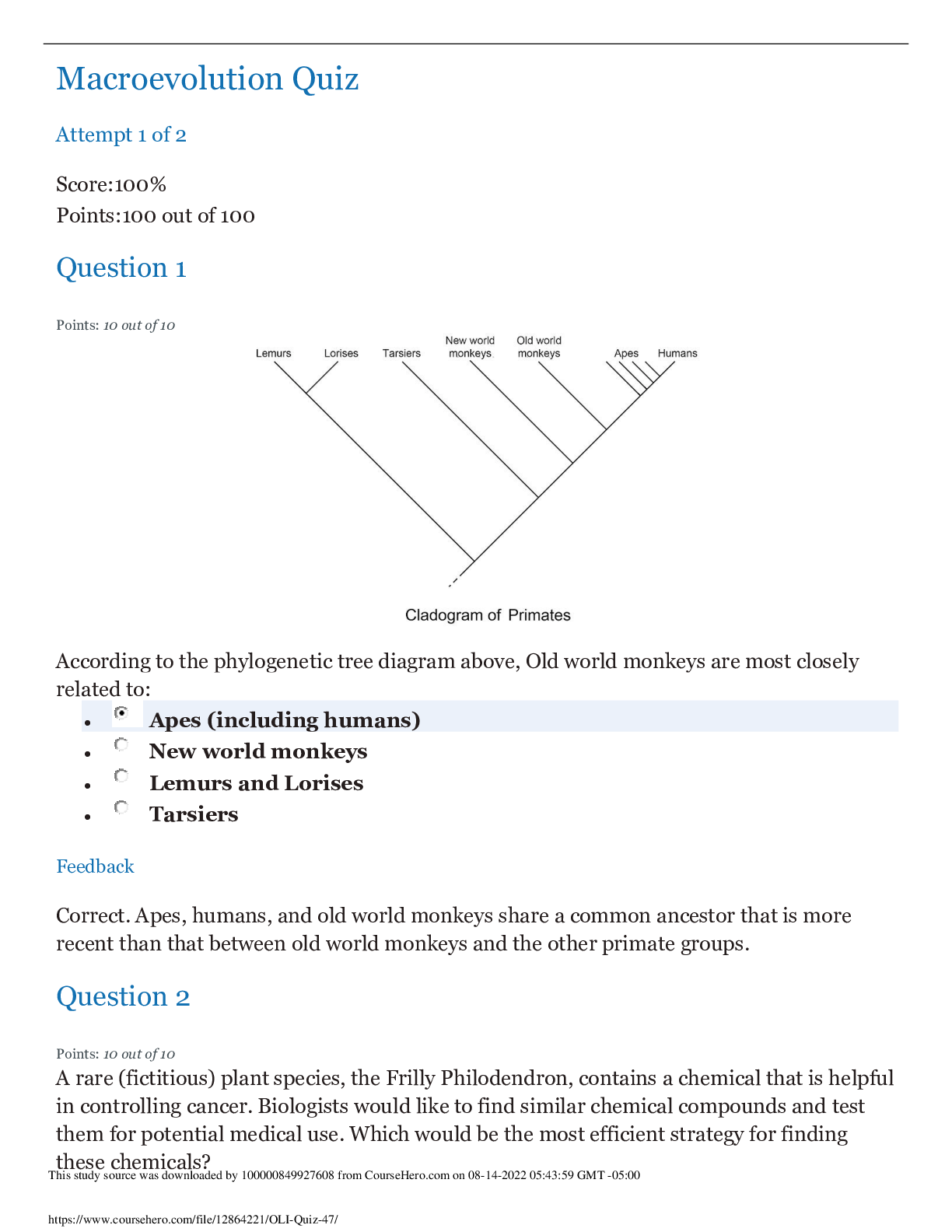

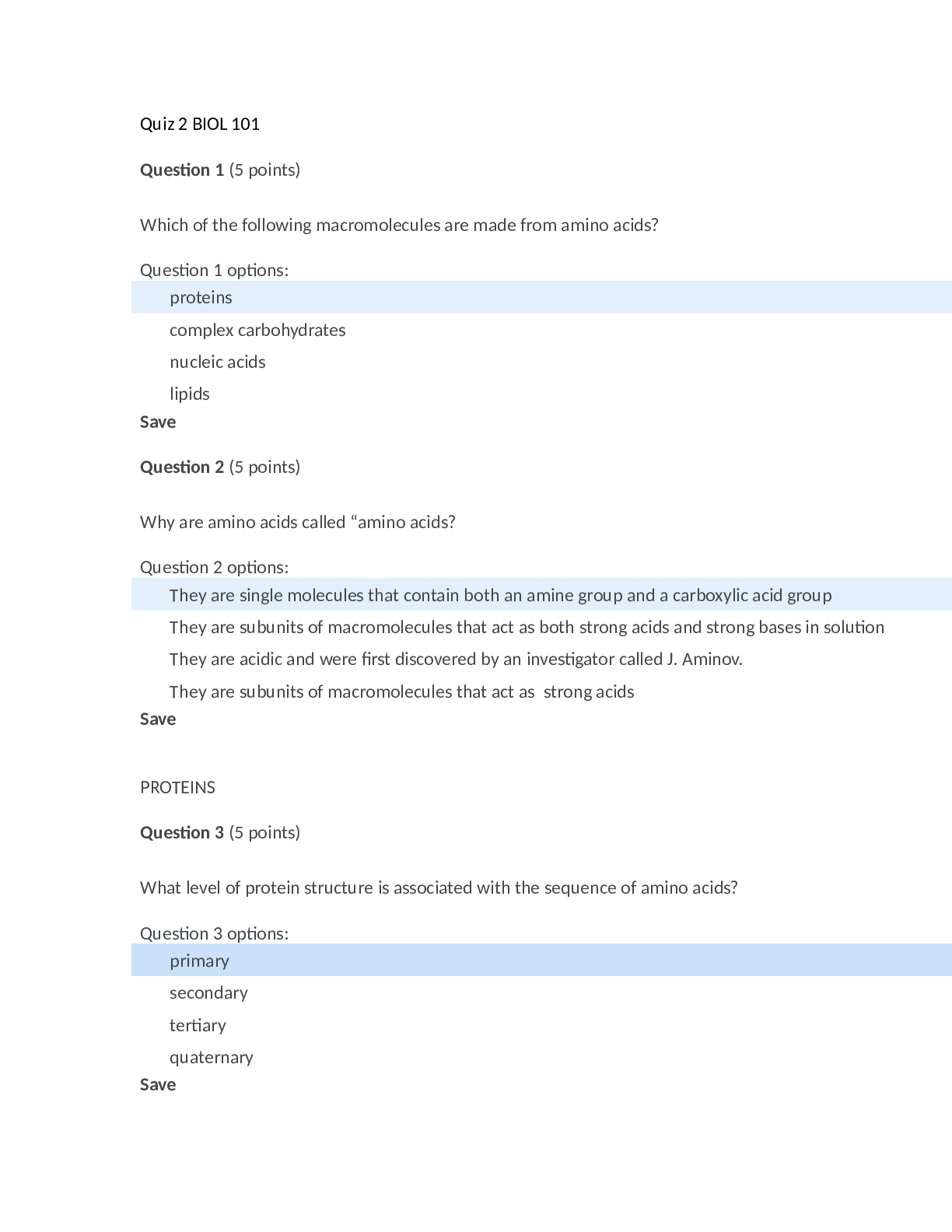
.png)
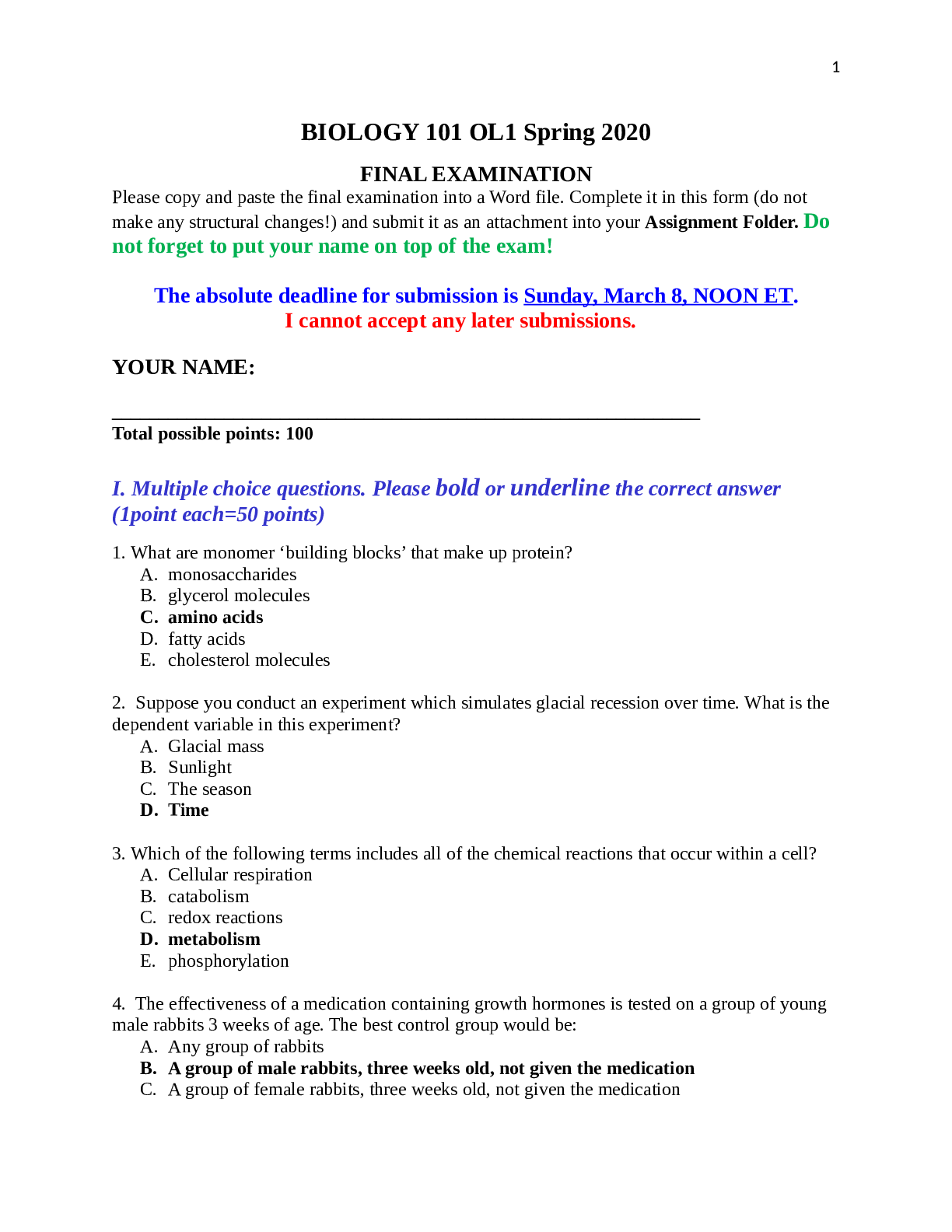
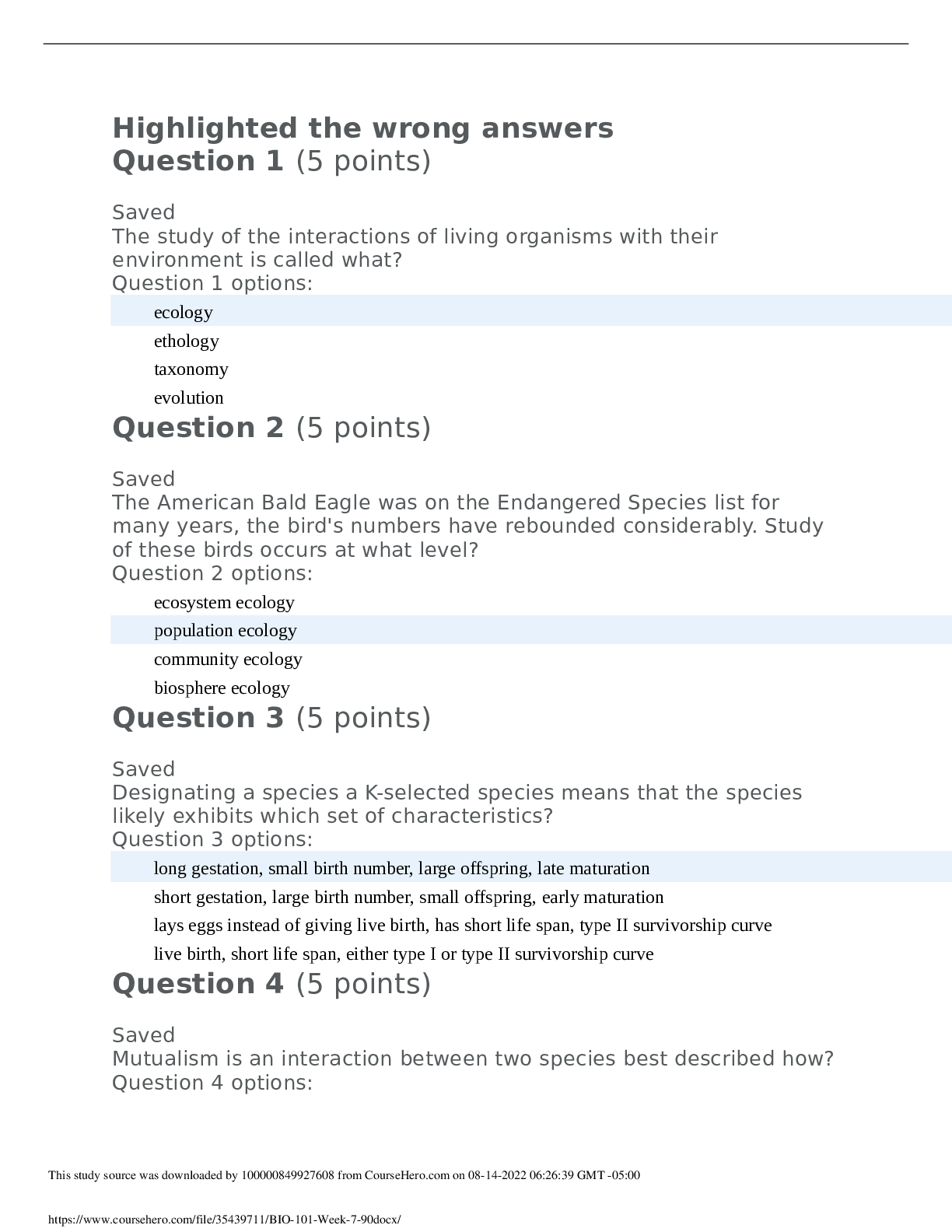

.png)
